Welcome to the blog on honey bee farming in India. This post will take a detailed look at the cost of starting a honey bee farming project in India, including the business plan, potential profits, and production ideas. Honey bee farming is an increasingly popular and profitable venture in India as the demand for honey and other bee-related products continue to rise.
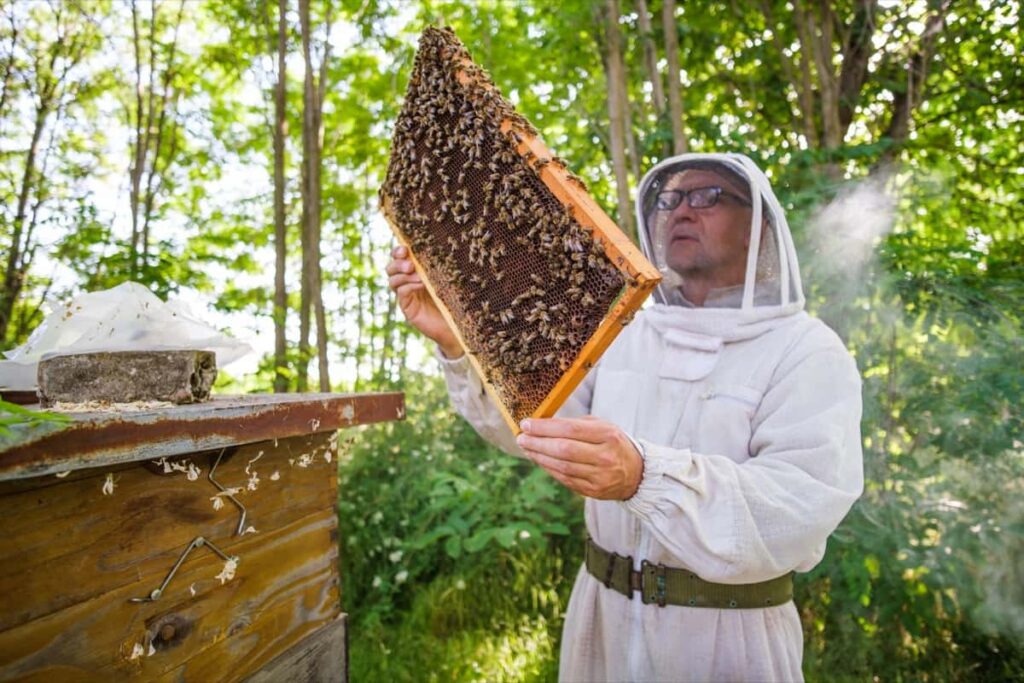
With proper planning and execution, a honey bee farming project can be a profitable and sustainable business. This post will discuss the necessary steps, costs, and considerations for starting a honey bee farming project in India and provide ideas for maximizing production and profits. Whether you are a seasoned beekeeper or new to the industry, this post will provide valuable information for starting and growing a successful honey bee farming business in India.
Beekeeping business plan
What is Honey Bee farming in India?
Honey bee farming, commonly known as beekeeping, is the care and breeding of honey bee colonies for producing honey and other bee-related goods such as propolis, beeswax, and royal jelly. In India, honey bee farming has a long history and is essential to the country’s agriculture sector. India is known for its diverse range of honeybee species, and honey production in India mainly uses Apis cerana and Apis mellifera species.
India is the second-largest honey producer in the world after China and has many beekeepers, most of whom are small-scale farmers. The country has a wide range of climatic and geographical conditions, which support the growth of different flora and fauna, thus providing a suitable environment for honeybee colonies. The honey produced in India is known for its high quality and unique taste, and it’s in high demand both locally and internationally.
India’s growing interest in honey bee farming as more and more people recognize the industry’s potential profits and benefits. The government of India has also been encouraging the development of the honey bee farming sector by providing financial and technical support to farmers and beekeepers. With proper planning and execution, a honey bee farming project can be a profitable and sustainable business in India.
In case you missed it: Honey Bee Contract Farming in India: Current Trend, Schemes, Companies, Cost, Profit, Process, Agreement, Pros, and Cons
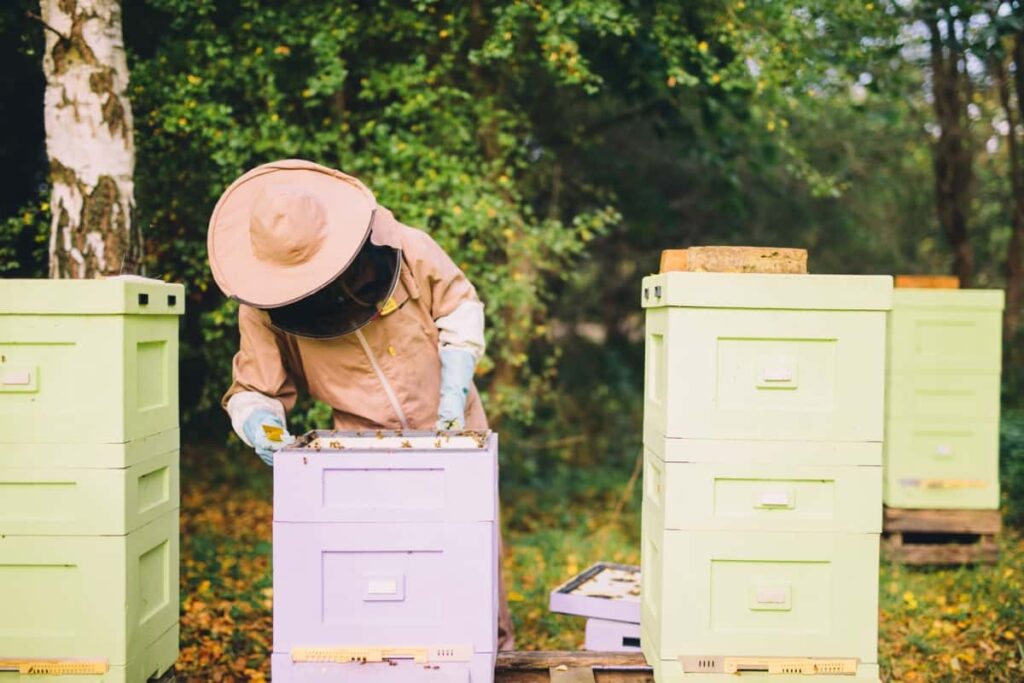
Products obtained from Beekeeping/ Bee farming.
- Honey is a sweet substance bee produce from the nectar of flowers.
- Beeswax is a natural waxy substance produced by honey bees and used in various industries. It is used in the cosmetic industry to make lotions, creams, and lip balms and in the medical industry as a wound dressing. It is also used as a coating for cheese and as a food additive. Beeswax is also widely used for making candles, as it is a natural, long-burning, and clean-burning wax. It also prepares polishes for shoes, furniture, and other items, creating a glossy, protective finish.
- Pollen: Pollen is collected by bees and used as a food source for the colony. It acts as a dietary supplement for humans and has been found to have anti-inflammatory properties.
- Propolis: Propolis is a sticky substance collected by bees from trees and plants. It is used to seal and protect the hive from pests and diseases. It is also used in the medical industry for its antibacterial and anti-inflammatory properties.
- Royal jelly is a milky-like substance produced by worker bees and fed to the queen bee. It is high in protein and vitamins and is a human dietary supplement.
- Venom: Venom from bees is used in the medical industry to treat bee venom therapy for conditions such as arthritis and multiple sclerosis.
- Bees: Bees themselves can also be sold for pollination services to farmers.
Importance and benefits of Honey Bee farming
Beekeeping provides important products such as honey and beeswax. Also, it plays a vital role in pollination, which increases crop yields. Additionally, recent studies have shown that bee venom has potential uses in the medical industry, specifically in the fight against HIV/AIDS. Overall, beekeeping is essential in the food and agricultural industries and the medical and cosmetic industries.
- Economic benefits: Honey bee farming provides a source of income by selling honey, beeswax, and other bee-related products.
- Pollination: Honey bees are essential pollinators for many crops, including fruits, vegetables, and nuts. It can increase crop yields and improve food security.
- Environmental benefits: Honeybees are crucial in maintaining biodiversity and preserving natural habitats. They also help to pollinate wild plants, which provide food for other wildlife.
- Health benefits: Honey is a natural and nutritious sweetener and has been shown to have antimicrobial and anti-inflammatory properties. Bee venom has also been found to have medicinal properties.
- Educational and research opportunities: Beekeeping can be a valuable educational tool for children and adults, providing opportunities for research on bees and the environment.
- A way to protect bees: Honey bee farming is a way to protect and preserve the honey bee population, which has been declining in recent years due to factors such as habitat loss and pesticide use.
Division of labor in a Bee colony
Different bees have various roles in a colony, including the queen bee, drone bees, and worker bees. The queen bee lays eggs while the drone bees help fertilize them. The worker bees in the hive are responsible for collecting nectar.
- Apiculture: Apiculture is the practice/rearing of beekeeping and honey production. Common varieties of bees that are reared for honey production include:
- Apis dorsata: Also called the rock bee, produces around 38-40 kg of honey per colony.
- Apis indica: Also known as the Indian bee, it is commonly used for honey production and can produce 2-5 kg of honey per colony per year.
- Apis florea: Also known as the little bee, it produces about 1-1.5 kg of honey per colony per year and is easy to extract from its hive.
- Apis mellifera: Also known as the Italian bee, it produces a high amount of honey and is often reared by beekeepers.
In case you missed it: Top 15 Agritech Startups Helping Farmers in India: Smart Farming for High Yields and Low Pests and Disease
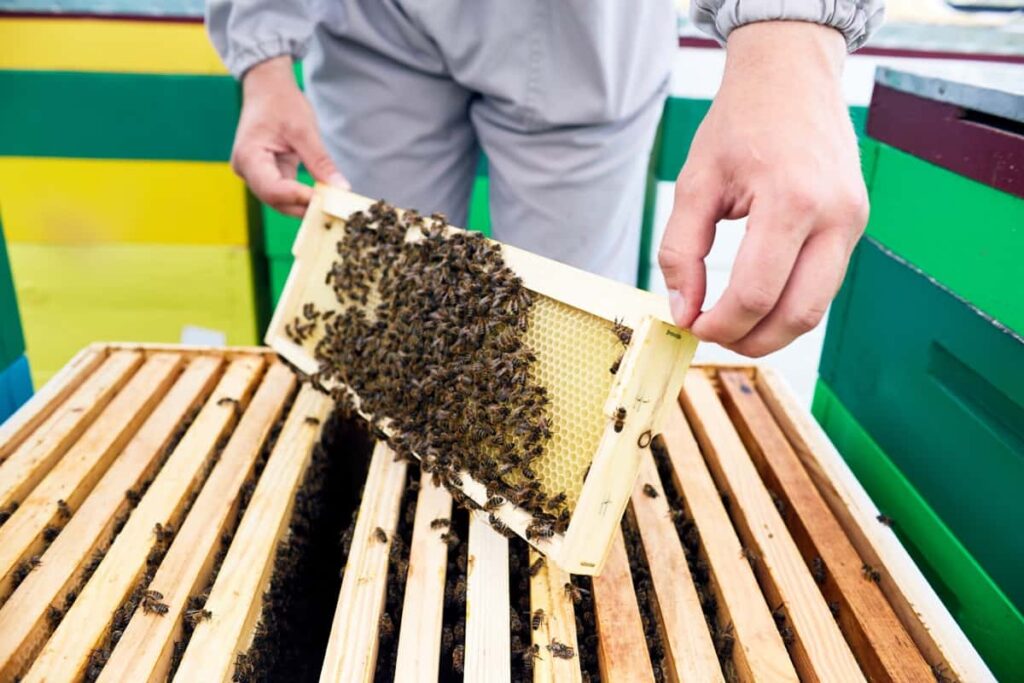
Bee colonies and different types of Bees
- A bee colony is a group of bees living together in a hive. The colony comprises three types of bees: the queen, the drones, and the workers.
- The queen bee is the reproductive female of the colony and is responsible for laying eggs and maintaining the genetic diversity of the colony. The queen bee is larger in size than the other bees and has a longer body.
- The drones are the male bees of the colony. Their main role is to fertilize the queen bee. They do not possess stingers and do not participate in hive maintenance.
- The worker bees are the female bees that make up most of the colony. They collect nectar, build comb, and protect the hive. They have stingers and are the only bees that can sting.
- The colony is organized into a hierarchical structure, with the queen at the top. The worker bees take care of the queen, the drones, and the young bees. The colony works together to ensure its survival of the colony.
Best production Ideas and techniques for Honey bee farming in India
Traditional bee farming
Traditional bee farming is a technique that has been practiced for a long time by Indian people. They used to keep bees in old-fashioned clay buildings, wooden logs, tree stem hollows, and wall gaps. Chopped “chhattas” were crushed or boiled on fire to extract honey from honey-filled roofs. This method resulted in muddy and unclean honey being sold at a lower rate in the local market.
Modern bee farming
Modern bee farming is a technique that has been developing for a long time and is popularly run by most new bee farmers. In this technique, bees are raised in modern artificial wood containers and are called modern beekeepers. Raising bees in a wooden box is beneficial as it does not harm the honey bee eggs, and honey can be quickly taken out from the box by the beekeeper. Proper care and a good relationship between the beekeeper and the bees are the main factors that affect honey production.
One can easily earn a high amount of profit with low investment. Top bar hive method This method of bee farming is highly adopted by people because of its advantages. The top bar hive is light in weight, easy to harvest honey, and bees experience low stress while creating honey. This method has been used as a traditional method by countries like Greece and Vietnam for a long time. It is common in Africa for honey collection. However, the comb cannot be reused after one-time honey extraction, which results in less honey production and affects the profit.
In case you missed it: How to Earn 1 Lakh Per Month from Tulsi: 1 Acre Holy Basil Cultivation/Farming/Production Project Report, Cost, Profitability Analysis
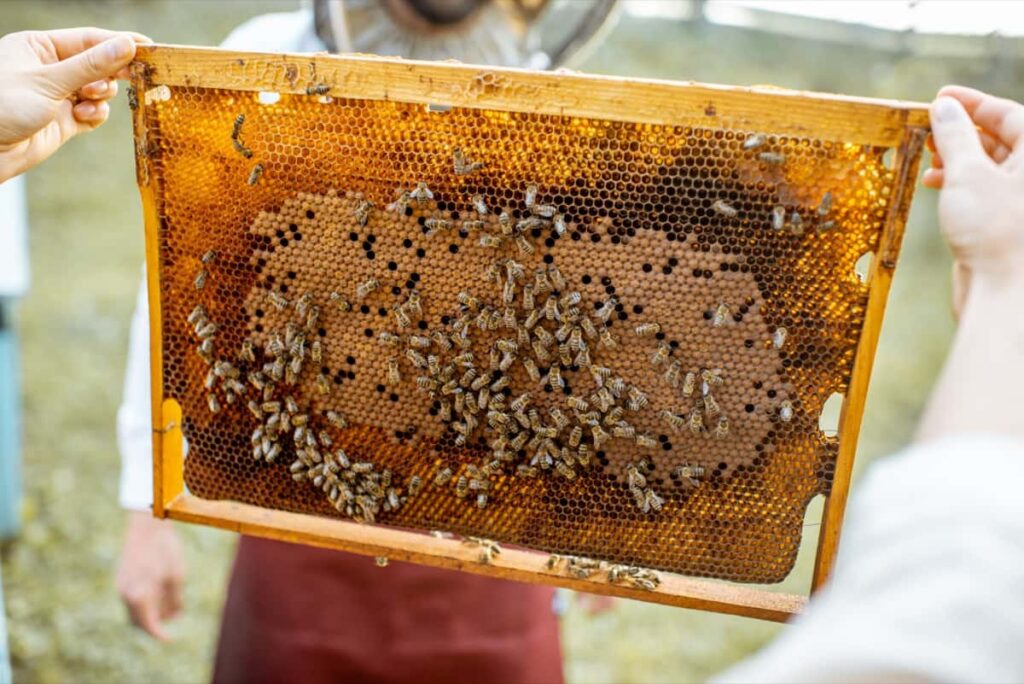
Hives with horizontal frames Because of the moveable frame used to harvest honey, this approach outperforms the fixed comb and top bar hives. After collecting the honey from the hive, it can be reset to gather it again. This approach is frequently used for commercial honey harvesting and is well suited to tropical agriculture.
Method of Vertically stackable frame hive This approach is widely employed in the United States and neighboring countries. The vast size of the hives is the key advantage of this strategy. The Rose hive is the most recent modification of this technology. This approach is frequently used for commercial honey harvesting and is well suited to tropical agriculture.
Equipment needed for Honey Bee Farming
Honey bee farming requires specific equipment to effectively manage and collect honey from the bees. The equipment includes:
- Honey extractor, which separates the honey from the comb.
- Bee venom collector is also necessary for those looking to collect and sell bee venom.
- Smoker is used to calm the bees during the honey harvesting process.
- Food-graded plastic queen cages and gates are needed to breed and manage the queen bee.
- Stainless steel hive tools in L-shaped and curved shapes are necessary for handling hives and comb.
- Knives are also necessary for cutting and manipulating the comb.
- Pollen trap is used to collect pollen from the bees, while a royal jelly production.
- Extraction kit are used to collect and process royal jelly.
- Beekeeping brushes in both thin and thick varieties are needed for handling bees.
- Iron hive tools and a hive gate are also necessary for managing the hives.
- Propolis strip is used to collect propolis, a sticky substance produced by the bees.
- Queen excluder is used to separate the queen bee from the rest of the hive.
- Queen-rearing kit is also necessary for breeding and managing the queen bee.
In case you missed it: Chicken Farming in Indonesia: Poultry Business Plan, Setup Cost, License, Profit, and Requirements
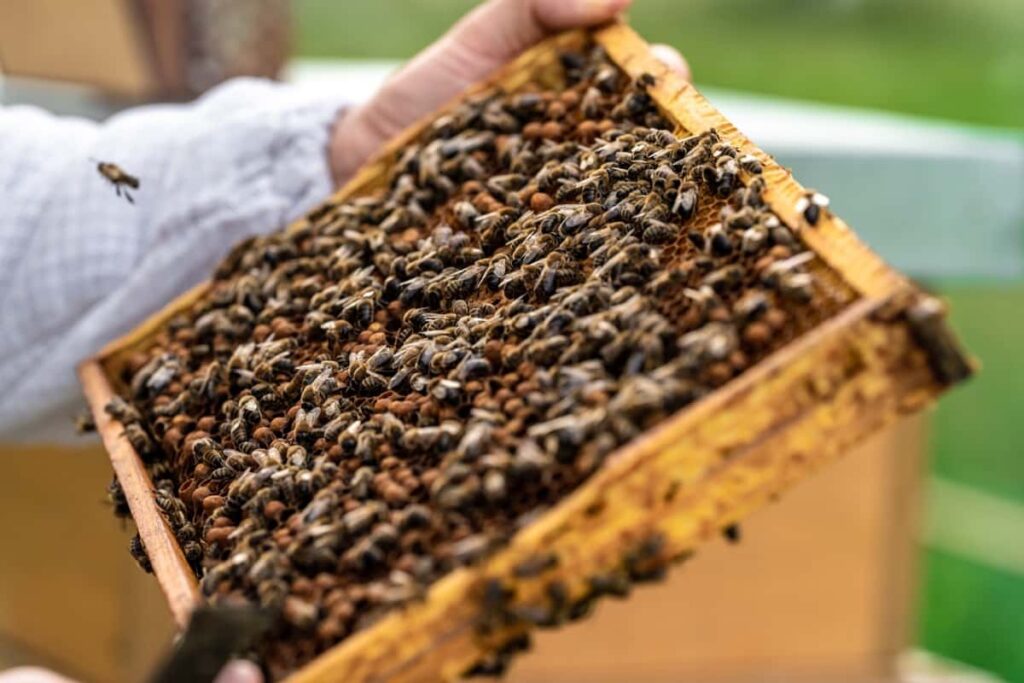
Honey bee farming in India: Business plan and project cost
India is one of the major honey-producing countries in the world, with a wide range of bee species and diverse floral diversity. A honey bee farming business in India can be profitable for those interested in beekeeping.
Business plan
- Research and Planning: Before starting the business, it is important to conduct thorough research on the bee species available in the region, the market demand for honey, and the costs involved in setting up and maintaining a bee farm.
- Location: A suitable location for the bee farm should be selected, considering factors such as the availability of floral diversity, water sources, and the proximity to the market.
- Bee Colonies: Purchase or rent bee colonies from local beekeepers or breed them in-house.
- Equipment: Acquire essential equipment such as hives, honey extractors, bee venom collectors, smokers, and other tools required for beekeeping.
- Maintenance and Care: Proper care and maintenance of bee colonies are essential for producing high-quality honey. It includes regular inspections of the hives, providing adequate food and water, and controlling pests and diseases.
- Marketing and Sales: Identify potential buyers and markets for the honey produced. It can include local markets, supermarkets, and online platforms.
Project cost
- Bee colonies: The cost of purchasing bee colonies can vary depending on the type of bees and the number of colonies needed. On average, a bee colony can cost between Rs. 5,000 and Rs. 20,000.
- Beekeeping equipment: Equipment such as bee hives, protective gear, honey extractors, and other tools will be needed for the beekeeping process. The cost of these items can vary depending on the quality and brand, but on average, the equipment can cost around Rs. 50,000 to Rs. 1,00,000.
- Land and infrastructure: The cost of land and infrastructure will depend on the location of the farm and the size of the land required. The land cost can range from Rs. 1,00,000 to Rs. 5,00,000.
- Labor costs: The labor cost will depend on the number of workers required to manage the bee farm and the hourly wages paid to them. On average, labor costs can range from Rs. 20,000 to Rs. 1,00,000.
- Marketing and advertising costs: The cost of marketing and advertising will depend on the marketing strategy used and the budget allocated for it. On average, marketing and advertising costs can range from Rs. 10,000 to Rs. 50,000.
The total project cost for a medium-sized honey bee farming enterprise in India can range from Rs. 2,00,000 to Rs. 7,00,000.
Sample project report on Honey bee farming in India
You will need to invest a few lakhs in starting this business, but the return will be enormous; honey is scarce on the market, and you can quickly sell organic honey at a rate of 400 to 700 Rs. Rates may differ from region to region depending on demand and honey producers. Here is some information regarding the honey bee farm’s costs and returns:
In case you missed it: How to Maximize Profit in Greenhouse Farming: Take an Advantage of Future Farming
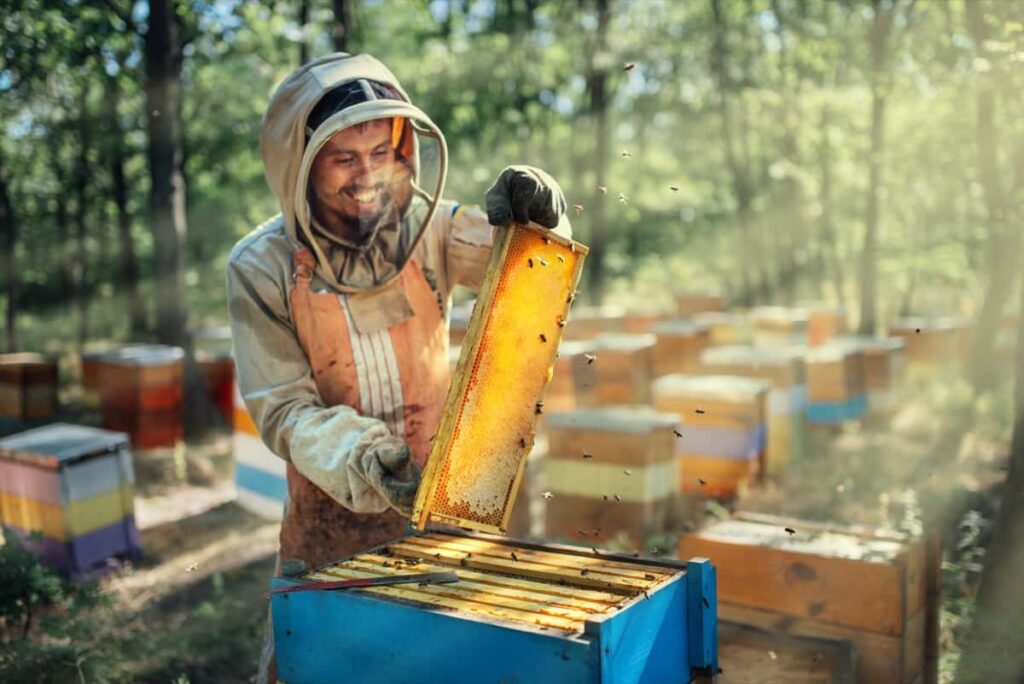
Investment
- Box of 100 Honey Bees
- Cost of each box is Rs. 3,500
- Total = 3,500 Rs multiplied by 100 boxes is Rs. 3,50,000
- Miscellaneous expenses = Rs. 1.750,000 (including worker wages, traveling costs, etc.).
- Total investment: Rs. 5,25,000
Income
Assuming most general conditions, 40-50 kg of honey is produced per box in a year.
- Total yield: 40 Kg per box x 100 Box = 4000 Kg Honey
- Honey rate: 350 per Kg
- Total income: Rs. 50 x 4,000 kg = Rs. 14,00,000 (14 lakh rupees approximately)
- Net Profit: 14,00,000 – 5,25,000 = 8,75,000. Per Month you can earn up to Rs. 70,000.
Loan availability and subsidies for bee farming business in India
- National Bank of Agriculture and Rural Development bank (NABARD)
- Small Industries Development Bank of India (SIDBI)
- National Minorities Development & Finance Corporation (NMDFC)
- Agri-Business Incubation (ABI)
- State Financial Corporations (SFCs)
Subsidies
The Central and State Governments of India provide subsidies for bee farming businesses to encourage and promote this sector. Some of the subsidies available are:
- National Bee Board: The National Bee Board provides financial assistance for beekeeping equipment and colonies.
- National Horticulture Board: The National Horticulture Board provides subsidies for beekeeping equipment and bee colonies to farmers.
- State Governments: Many governments in India provide subsidies for beekeeping equipment and bee colonies. These subsidies vary from state to state.
Checking with the relevant authorities and financial institutions for the most up-to-date information is recommended.
In case you missed it: Growing Potatoes Organically in Telangana: Step-by-Step Cultivation and Production
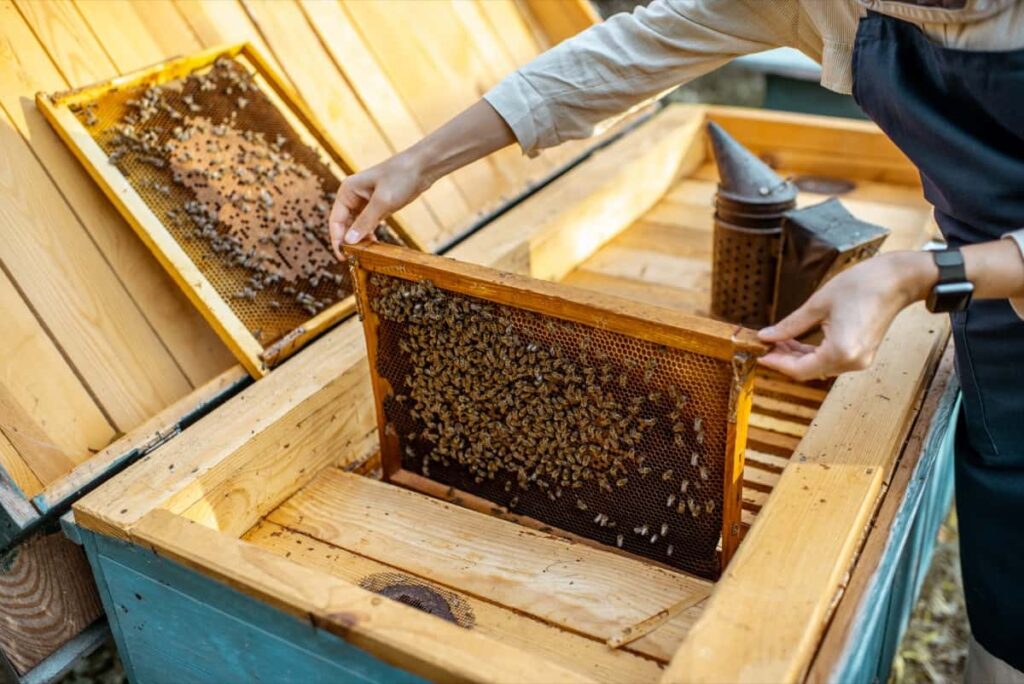
Conclusion
Starting a honey bee farming project in India can be a profitable business venture with a low initial investment. A business plan should be developed to outline the costs, profits, and production goals. To successfully start a honey bee farming project in India, a business plan outlining costs, profits, and production goals is essential, as well as good knowledge of beekeeping techniques and the local market for honey and beeswax. Potential challenges such as disease and pests should also be considered. Proper planning and management can lead to a sustainable and profitable business.
- Sheep Farming Business Plan for Beginners
- Aquaponic Farming at Home: A Step-By-Step Guide
- Profitable Village Farming Business Ideas in 2024
- High-Yield Aquaculture: Fast-Growing Fish for Farming
- Effective Fish Pond Construction Techniques for Beginners
- Irrigation and Water Management in Pineapple Farming
- Blossom to Harvest: Mastering Flowering and Pollination in Papaya Farming
- Pig Fattening Essentials: From Selection to Sale for Beginners
- Raising Wagyu Cattle: A Complete Guide for Premium Beef Production
- Soil Types and Their Water Holding Capacity
- Optimizing Irrigation Schedules for Coconut Groves for Enhanced Yield
- Espresso Your Garden: Coffee Grounds for Healthier Acid-Loving Plants
- The Best Soil Mix for Snake Plants: How to Mix Your Own Snake Plant Soil
- Green Thumb Success: Expert Tips for Cultivating Greenhouse Beans All Year Round
- Bloom All Year Round: The Ultimate Guide to Indoor Hyacinth Care
- Eco-Friendly Gardening: How to Make Liquid Fertilizer from Kitchen Waste
- Ultimate Guide to Grow Anise in Pots: Explore Seed Propagation to Harvesting
- Guide to Raising Chester White Pigs: Discover Breed Facts to Growth Management
- Mastering the Elegance: The Ultimate Guide to Weeping Cherry Tree Care, Planting, and Maintenance
- Ultimate Guide to Planting Garlic in Grow Bags: Growing Strategies for Beginners
- How to Fix Spider Plant Leaf-Related Problems: Natural and Organic Remedies
- 10 Reasons Why Your Tulsi Plant is Shedding Leaves: Home Remedies and Solutions
- Optimizing Growth and Yield: The Advantages of Palm Bunch Ash Fertilizer
- Utilizing Neem Oil Extract as a Natural Pesticide for Hydrangea
- From Soil to Harvest: Various Ways in Which Farmers Can Use AI Tools
- Steps to Encourage and Induce Citrus Flowers: A Comprehensive Guide
- How to Fix Snake Plant Leaf-Related Issues: Natural and Organic Remedies
- Transform Your Garden into a Fragrant Oasis with Raat Ki Rani (Night Blooming Jasmine)
- Discover the Ideal Chicken Breeds for Philippine Farms
- How to Create a Poultry Egg Farm Business Plan for Profits
- Grow Lemon Cucumbers Like a Pro: Insider Techniques for Bountiful Yields
- Ultimate Guide to Caring for Your Pink Princess Philodendron: Tips for Thriving Variegation
- Areca Nut Profit Per Acre: Calculating Yield and Cost of Cultivation
- How Kaveri Chicken is Becoming a More Profitable Breed in Indian Backyards
- Transform Your Barn: 9 Steps to Convert a Horse Stall into a Chicken Coop
- Exploring Suffolk Sheep Disadvantages with Limitations and Challenges

Good information thanks
Thanks
GOOD INFORMATION THANKS
Thanks to this website, this has cleared my all doubts . I will send you my honey one day surely